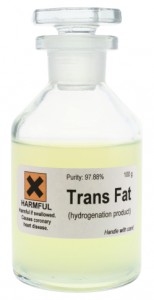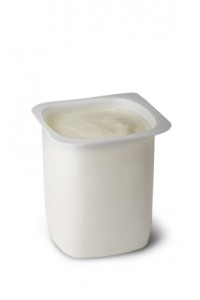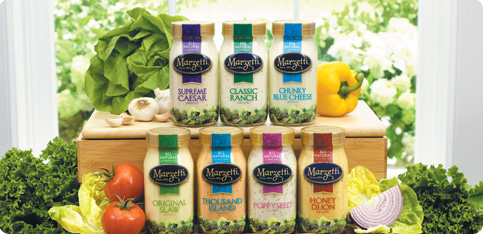‘You can’t go wrong with a salad.’ At least, that was the old way of thinking.
These days, salads have become as much of a blank canvass as sliced bread, allowing anything from exotic fruits to bizarre meats to be tossed in to the mix, often blurring the line between healthy and unhealthy.
Yet, even in the case of the good ol’ plain salad, one ingredient remains perhaps the worst of the bunch, and it’s often overlooked…
Salad dressing.
Just as it can make or break the flavor of the salad, it can also make or break your wellness efforts.
With multiple shelves dedicated to the dozens of kinds of salad dressing at any grocery store– reduced- fat, fat-free, sugar-free, calorie-free, vitamin-enriched — where does one start to sort the healthy from the harmful?
Unfortunately, the majority of store-bought salad dressings are extremely processed; they’re often laden with unhealthy ingredients that will ruin every good intention you had for eating salad in the first place.
Below are some of the reasons to steer clear of conventional salad dressing.

1. They contain trans-fats:
If you turn the bottle over and read the ingredients list, you’ll more than likely find the words “partially hydrogenated soy/corn/cottonseed/etc oil.” This is a form of trans-fat, an extremely unhealthy fat known to increase levels of unhealthy cholesterol, cause weight gain even in a calorie-restricted diet, increase risk of coronary artery disease, and redistribute fat to the abdominal region of the body– the unhealthiest place to store fat.
2. They’re loaded with sugar: Here’s a label-reading tip: the first ingredient on the list is the most abundant of all the ingredients. If sugar is among the first 3-5 ingredients listed, then drenching your salad with the dressing would give you the equivalent carbohydrate intake of about a breadstick or two (or three).
3. They have preservatives and harmful additives: Artificial flavors are usually clearly labeled, but beware of deceiving names such as “nature-identical flavors” or “natural flavors”, which are really disguises for harmful additives like MSG (monosodium glutamate), a nerve toxin shown to cause obesity bu shutting off satiety centers in the brain.
4. They are contained in plastic containers:

To add insult to injury, the majority of store-brought dressings are contained in plastic bottles, which more than likely contain Bisphenol-A (BPA), a chemical known to disrupt your body’s endocrine (or hormonal) system, causing a variety of maladies from reproductive problems in adults to deficits in brain development in kids and even unborn children. If you’re lucky, you can find dressings in glass bottles, which are not only safer than plastics, but can be reused to store homemade salad dressings.
Are you doomed to eating dry salad from now on? Hardly; far from it, in fact. There are plenty of savory healthy salad dressings out there that are extremely easy to make, even if your highest culinary achievement is boiling water. Here are a few simple ideas for delectable and healthy salad dressings.
Oil and Vinegar: Mix olive oil with balsamic vinegar. That’s it! It usually tastes better when you have more vinegar than oil, but play around with the proportions and see what you like best. If you’re daring, try different vinegars (ie. Apple cider vinegar, white vinegar, etc) or even different oils (tip: keep the oils healthy, as in the case of avocado oil, coconut oil, or perhaps even sesame oil).
Avocado Dressing: Mix avocado meat with lemon juice, unprocessed salt, and freshly crushed garlic, to taste. Throw in a pinch of black pepper if you want a little kick. This dressing is a bit different in that you don’t pour it over your salad (after all, it’s not a liquid). It may seem like you’re eating a dry salad, but the flavor is so good, you won’t mind it at all. Play with different spices as you get a better feel for the different flavors in the salad.
Yogurt Dressing: Using plain yogurt, mix about 2/3 cup with a bit of dijon mustard, cilantro and chives. If you’ve got a variety of spices in the kitchen, or are growing your own herbs, let your creativity go to work and find the combinations that float your boat. Again, there’s no right or wrong combination of herbs or spices- it’s all up to you.. Plain yogurt is an excellent substitute for mayonnaise-based dressings, not to mention a great canvas to work with, able to take on almost any flavor you want.
Fruity Infusions: Fruits make unique additions to any salad, not just for their flavors but for their interesting textures. Take some of your favorite fruits– tart or sweet ones work best, like strawberries, mangoes, or raspberries– then blend/mash them, and top off with a sprinkle of sea salt or himalayan salt. Combine different fruits if you like, or add just a small amount of fruit to a vinaigrette for a one-of-a-kind flavor. Not in a blending mood? Just chop up the fruits and toss them into the salad. Think of it as having dessert with your salad!
If you enjoy this article, do check the next page out ->
About the Author:
Emma Deangela is the best selling author of The Alkaline Diet Program and 80/20 Fat Loss. She has helped over tens of thousands of men and women to lose weight and transform their health with sound nutrition advice.
Which wonderful friends in your life are blindly adding salad dressings to their salad without knowing that salad dressings could be sabotaging their weight loss?
Please help them achieve their fat loss goals and better health by sharing this eye-opening article with each of them using any of the social media and email buttons below.


Leave a Reply